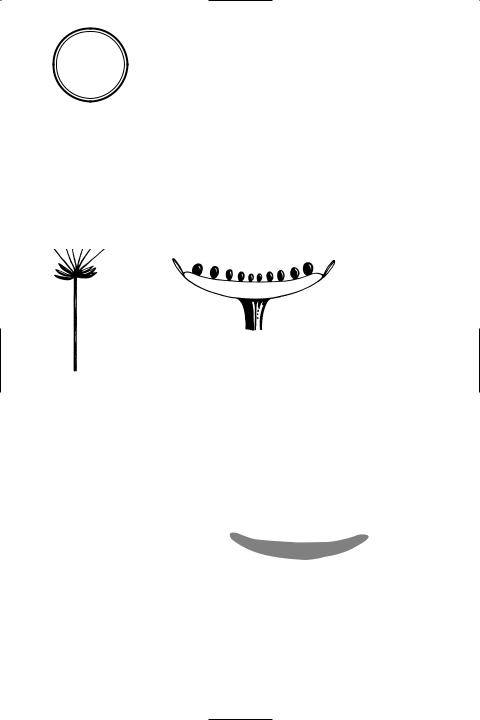
A Dictionary of Science
.pdf
Q
QCD See quantum chromodynamics.
QED See quantum electrodynamics.
QFD Quantum Ûavourdynamics. See electroweak theory.
QSG See quasars.
QSO See quasars.
QSS See quasars.
quadrat An ecological sampling unit consisting of a small square area of ground within which all species of interest are noted or measurements taken. Quadrats may be spaced over a larger area to form an overall view when a total survey would be impracticable, or they may be used to sample along a *transect.
quadrate A paired bone in the upper jaw of bony Üshes, amphibians, reptiles, and birds that articulates with the lower jawbone. It is absent in mammals, being reduced to a small bone (the incus) in the middle ear (see ear ossicles).
quadratic equation An equation of the second degree having the form ax2 + bx + c = 0. Its roots are:
x = [–b ± √(b2 – 4ac)]/2a.
quadrature The position of the moon or an outer planet when the line joining it to the earth makes a right angle with a line joining the earth to the sun.
quadrivalent Having a valency of four.
qualitative analysis See analysis.
qualitative variation See discontinuous variation.
quality of sound (timbre) The quality a musical note has as a result of the presence of *harmonics. A pure note consists only of the fundamental; however, a note from a musical instrument will have several harmonics present, depending on the type of instrument and the way in which it is played. For example, a plucked string
(as in a guitar) produces a series of harmonics of diminishing intensity, whereas a struck string (as in a piano) produces a series of harmonics of more nearly equal intensity.
quantitative analysis See analysis.
quantitative inheritance See polygenic inheritance.
quantitative variation See continuous variation.
quantization The process of constructing a quantum theory for a system, using the original classical theory as a basis.
The starting point for such a process is to write the *Lagrangian or *Hamiltonian of the classical system. The formulation of the quantum theory for the system can be performed using a formalism such as *matrix mechanics, or *wave mechanics. The application of these methods leads to the conclusion that energy levels in systems, such as atoms, are discrete (quantized) rather than continuous. Before the discovery of quantum mechanics in the mid 1920s, quantization involved a series of ad hoc postulates for atomic systems, such as the *Bohr theory and its extensions.
quantum (pl. quanta) The minimum amount by which certain properties, such as energy or angular momentum, of a system can change. Such properties do not, therefore, vary continuously, but in integral multiples of the relevant quantum, and are described as quantized. This concept forms the basis of the *quantum theory. In waves and Üelds the quantum can be regarded as an excitation, giving a particle-like interpretation to the wave or Üeld. Thus, the quantum of the electromagnetic Üeld is the *photon and the *graviton is the quantum of the gravitational Üeld. See quantum mechanics.
quantum chaos The *quantum mechanics of systems for which the corresponding classical system can exhibit

677 |
quantum gravity |
*chaos. This subject was initiated by Einstein in 1917, who showed that the quantization conditions associated with the *Bohr theory need to be modiÜed for systems that show chaos in classical mechanics. The subject of quantum chaos is an active Üeld of research in which many basic issues still require clariÜcation. It appears that systems exhibiting chaos in classical mechanics do not necessarily exhibit chaos in quantum mechanics.
quantum chromodynamics (QCD) A
*gauge theory that describes the strong interaction in terms of quarks and antiquarks and the exchange of massless gluons between them (see also elementary particles). Quantum chromodynamics is similar to quantum electrodynamics (QED), with colour being analogous to electric charge and the gluon being the analogue of the photon. The gauge group of QCD is non-Abelian and the theory is much more complicated than quantum electrodynamics; the gauge symmetry in QCD is not a *broken symmetry.
QCD has the important property of *asymptotic freedom – that at very high energies (and, hence, short distances) the interactions between quarks tend to zero as the distance between them tends to zero. Because of asymptotic freedom, perturbation theory may be used to calculate the high energy aspects of strong interactions, such as those described by the *parton model.
quantum electrodynamics (QED) The study of the properties of electromagnetic radiation and the way in which it interacts with charged matter in terms of *quantum mechanics. The collision of a moving electron with a proton, in this theory, can be visualized by a space–time diagram (Feynman diagram) in which photons are exchanged (see illustration).
e– |
e– |
e– |
e– |
|
photon |
*Perturbation-theory calculations using Feynman diagrams enable an agreement between theory and experiment to a greater accuracy than one part in 109 to be obtained. Because of this, QED is the most accurate theory known in physical science. Although many of the effects calculated in QED are very small (about 4 × 10–6 eV), such as *energy level splitting in the spectra of *atoms, they are of great signiÜcance for demonstrating the physical reality of Ûuctuations and polarization in the vacuum state.
QED is a *gauge theory for which the gauge *group is Abelian.
quantum electronics The application of *quantum optics and the speciÜcally quantum-mechanical properties of electrons to the design of electronic devices.
quantum entanglement A phenomenon in quantum mechanics in which a particle or system does not have a deÜnite state but exists as an intermediate form of two ‘entangled’ states. One of these states is realized when a ‘measurement’ is made. See bell’s theorem.
quantum Üeld theory A quantummechanical theory applied to systems that have an inÜnite number of degrees of freedom. In quantum Üeld theories, particles are represented by Üelds that have quantized normal modes of oscillation. For instance, *quantum electrodynamics
is a quantum Üeld theory in which the q photon is emitted or absorbed by parti-
cles; the photon is the quantum of the electromagnetic Üeld. Relativistic quantum Üeld theories are used to describe fundamental interactions between elementary particles. They predict the existence of *antiparticles and also show the connection between spin and statistics that leads to the Pauli exclusion principle (see spin–statistics theorem). In spite of their success, it is not clear whether a quantum Üeld theory can give a completely uniÜed description of all interactions (including the gravitational interaction).
quantum Ûavourdynamics (QFD) See
electroweak theory.
An example of a Feynman diagram for electronelectron scattering
quantum gravity An aspect of *quantum theory that attempts to incorporate

quantum Hall effect |
678 |
the *gravitational Üeld as described by the general theory of *relativity; no such theory has yet been accepted, however. Unlike the *quantum Üeld theories for the other three *fundamental interactions, the procedure of *renormalization does not work for quantum gravity, although there is some evidence that *superstring theory can provide a quantum theory of gravity free of inÜnities. An approximation to quantum gravity is given by quantum Üeld theory in curved space–time, in which the gravitational interactions are treated classically, while all other interactions are treated by *quantum mechanics. An important aspect of quantum Üeld theory in curved space– time is its description of Hawking radiation (see hawking process). It is necessary to consider quantum gravity in the very *early universe, just after the *big bang, and the singularities associated with *black holes can also be interpreted as requiring a quantum theory of gravity.
quantum Hall effect A quantum mechanical version of the *Hall effect found at very low temperatures, in which the Hall coefÜcient RH is proportional to h/e2, where h is the Planck constant and e is the charge of the electron. Thus, the Hall coefÜcient is quantized. There are two types of quantum Hall effect. The integer quantum Hall effect has RH given as an in-
qfor precision measurements of constants such as e and h. In the fractional quantum
Hall effect, RH has fractional values.
The integer quantum Hall effect can be understood in terms of noninteracting electrons, whereas the fractional effect is thought to result from many-electron interactions in two-dimensional systems, and be an example of anyons (see quantum statistics).
quantum jump A change in a system (e.g. an atom or molecule) from one quantum state to another.
quantum mechanics A system of mechanics based on *quantum theory, which arose out of the failure of classical mechanics and electromagnetic theory to provide a consistent explanation of both
*electromagnetic waves and atomic struc- ture. Many phenomena at the atomicteger with great precision. It can be used
level puzzled physicists at the beginning of the 20th century because there seemed to be no way of explaining them without making use of incompatible concepts. One such phenomenon was the emission of *electrons from the surface of a metal illuminated by light. Einstein realized that the classical description of light as a wave on an electromagnetic Üeld could not explain this *photoelectric effect, as it is called. Experiments showed that electrons would be emitted only if the incident light was of a sufÜciently short wavelength, while the intensity of the light appeared not to be relevant. It seemed not to make sense that small ripples of short wavelength could easily knock electrons out of the metal, but a huge tidal wave of long wavelength could not. In 1905 Einstein abandoned classical mechanics and sought an explanation of this photoelectric effect in Planck’s work on thermal radiation (see planck’s radiation law). In this work light energy is regarded as being imparted to matter in discrete packets rather than continuously, as one might expect from a wave. Einstein assumed that in the photoelectric effect, light behaves as a shower of particles, each with energy E given by Planck’s expression:
E = hf,
where f is the light’s frequency and h is the *Planck constant. Each particle of light, which Einstein called a *photon, would impart its energy to a single electron in the metal. The electron would be liberated only if the photon could impart at least the required amount of energy. However many photons were falling on the surface of the metal, no electrons would be liberated unless individual photons had the required energy (hf ) to break the attractive forces holding the electrons in the metal. This elegantly quantiÜed reversion to Newton’s corpuscular theory of light by Einstein was one of the milestones in the development of quantum mechanics.
Further veriÜcation that light could indeed behave as a shower of particles came from the *Compton effect. In Compton scattering, X-radiation is scattered off an electron in a manner that resembles a particle collision. The momentum im-

679 |
quantum mechanics |
parted to the electron can be predicted by assuming that the X-ray possesses the momentum of a photon. An expression for photon momentum is suggested by the classical theory of radiation pressure. It is known that if energy is transported by an electromagnetic wave at a rate W joules per unit area per second, the wave exerts a radiation pressure W/c, where c is the speed of light. Planck’s expression for the energy of photons therefore led to an equivalent expression for the momentum p of these photons:
p = h/λ,
where λ is the wavelength of the light. Experimental studies of the Compton effect produce results in good agreement with this expression.
Both the photoelectric effect and the Compton effect imply that light imparts energy and momentum to matter in the form of packets. It is as if energy and momentum are fundamental ‘currencies’ of physical interaction, and that these currencies exist in denominations that are all multiples of the Planck constant. These quantities are said to be ‘quantized’ and a packet of energy or momentum is called a *quantum. Quantum mechanics is essentially concerned with the exchange of these quanta of energy and momentum. For more than a century before the birth of quantum mechanics, experiments had indicated that light behaves as a wave. The successful explanation of the photoelectric and Compton effects demonstrated that in some situations light interacts with matter as if it is a shower of particles. The principle that two models are required to explain the nature of light was called by Niels Bohr *complementarity. This principle was extended by the French aristocrat, Louis de Broglie, who suggested in 1923 that particles of matter might also behave as waves in certain circumstances.
Louis de Broglie received the Nobel Prize for this idea in 1929 after the successful measurement of the *de Broglie wavelength of an electron in 1927 by Clinton Davisson and Lester Germer, who had observed the *diffraction of electrons by single crystals of nickel. The behaviour of individual electrons seemed random and unpredictable, but when a large number
had passed through the crystal a typical diffraction pattern emerged. This provided proof that the electron, which until then had been thought of simply as a particle of matter, could under the right circumstances exhibit wavelike properties. Classical mechanics and electromagnetism were based on two kinds of entity: matter and Üelds. In classical physics, matter consists of particles and waves are oscillations on a Üeld. Quantum mechanics blurs the distinction between matter and Üeld. Modern physicists are forced to concede that the universe is made up of entities that exhibit a *wave–particle duality.
A new representation of matter and Üeld is needed to fully appreciate this wave–particle duality. In quantum mechanics, an electron is represented by a *complex number called a *wave function that depends on time and space coordinates. The wave function behaves like a classical wave displacement on a medium (e.g. on a string), exhibiting wave behaviour, interference, diffraction, etc. However, unlike a classical wave displacement, the wave function is essentially a complex quantity. Since an electron’s observable properties do not involve complex numbers, it follows that an electron’s wave function cannot itself be identiÜed with a single physical property of the electron. The diffraction of electrons observed by Davisson and Germer revealed that, al-
though the behaviour of the individual q electrons is random and unpredictable,
when a large number have passed through the apparatus, a diffraction pattern is formed whose intensity distribution is proportional to the intensity of the associated wave function. The intensity of the wave function, Ψ, is the square of its *absolute value |Ψ|2. Therefore, although an electron’s wave function itself has no physical signiÜcance, the square of its absolute value at a point turns out to be proportional to the probability of Ünding an electron at that point.
The electron wave function must satisfy a wave equation based on the conservation of energy and momentum for the electron. There are two main ways of treating this wave equation: a classical or a relativistic treatment. The resulting wave equations are called eigenvalue equations because they have the same

quantum number |
680 |
form as equations in a branch of mathematics called eigenvalue problems, i.e.
ΩΨ = ωΨ,
where Ω is some mathematical operation (multiplication by some number, differentiation, etc.) on the wave function Ψ and ω, called the eigenvalue in quantum mechanics, is always a real number. In such an equation the wave function is often called the eigenfunction. This form of treatment of quantum mechanics is known as wave mechanics (see also
schrödinger equation).
The energy E and momentum p of an electron are associated with the frequency f and wavelength λ of the electron’s wave using the expressions E = hf and p = h/λ. While the wave equation expresses the behaviour of the wavelike properties of a particle, it does not deÜne the physical attributes it has as a particle. As a particle, the electron has an easily deÜned spatial and temporal position, not possessed by an oscillation of some kind of Üeld, whose inÛuence extends over a region of space and time. The incompatibility of these two views of the electron leads to the Heisenberg *uncertainty principle. Heisenberg recognized that if matter had wavelike properties, the physical attributes normally associated with matter (position, momentum, kinetic energy, etc.) would have to be expressed in a sta-
qtistical, rather than a deterministic, manner. This is illustrated by the electron diffraction patterns of Davisson and Germer. Individual electrons somehow fell onto the apparatus to form a pattern sta-
tistically consistent with the intensity of a wave function. It is as if the Ünal wave function were made up of a superposition of all the possible positions that the electrons could fall onto, the waves of elec-
trons constructively and destructively interfering to form the Ünal diffraction pattern.
It is known that a clever superposition of waves of different wavelengths can
lead to a construction of a wave packet of Ünite extension (see fourier analysis). However, to produce a packet that exists
at a point of zero width requires an inÜnite number of waves to superimpose. Heisenberg realized that these packets of waves must account for the way in which
matter particles, such as electrons, could retain some semblance of their particlelike qualities. However, this must also mean that there is an inherent uncertainty in position and momentum associated with electrons and indeed all particles of matter (see uncertainty principle). Since waves of different wavelength correspond to different possible momentum values of an electron, a superposition of such waves to form a particle at a point would correspond to an inÜnite uncertainty in the momentum of the electron. Therefore the more one knows about the position of an electron the less one will know about its momentum and vice versa. A similar uncertainty between the energy of the electron and its temporal position also exists. Quantities that are related by such an uncertainty principle are said to be incompatible.
An alternative to the wave mechanical treatment of quantum mechanics is an equivalent formalism called *matrix mechanics, which is based on mathematical operators. See also hidden-variables theory; bell’s theorem.
quantum number See atom; spin.
quantum optics The study of those aspects of light that rely on *quantum mechanics. Quantum optics makes use of the *quantum theory of radiation to describe photons, *coherent radiation, and the interaction of photons and atoms. The study of *lasers is an important branch of quantum optics; other applications include photonics and *quantum electronics.
quantum simulation The mathematical modelling of systems of large numbers of atoms or molecules by computer studies of relatively small clusters. It is possible to obtain information about solids and liquids in this way and to study surface properties and reactions.
quantum state The state of a quantized system as described by its quantum numbers. For instance, the state of a hydrogen *atom is described by the four quantum numbers n, l, ml, ms. In the ground state they have values 1, 0, 0, and ½ respectively.
quantum statistics A statistical de-

681 |
quark confinement |
scription of a system of particles that obeys the rules of *quantum mechanics rather than classical mechanics. In quantum statistics, energy states are considered to be quantized. Bose–Einstein statistics apply if any number of particles can occupy a given quantum state. Such particles are called bosons. Bosons have an angular momentum nh/2π, where n is zero or an integer and h is the Planck constant. For identical bosons the *wave function is always symmetric. If only one particle may occupy each quantum state,
Fermi–Dirac statistics apply and the particles are called fermions. Fermions have a total angular momentum (n + ½)h and any wave function that involves identical fermions is always antisymmetric.
The relation between the spin and statistics of particles is given by the *spin–statistics theorem.
In two-space dimensions, it is possible that there are particles (or *quasiparticles) that have statistics intermediate between bosons and fermions. These particles are known as anyons; for identical anyons the wave function is not symmetric (a phase sign of +1) or antisymmetric (a phase sign of –1), but interpolates continuously between +1 and –1. Anyons may be involved in the fractional *quantum Hall effect.
quantum theory The theory devised by Max Planck in 1900 to account for the emission of the black-body radiation from hot bodies. According to this theory energy is emitted in quanta (see quantum), each of which has an energy equal to hν, where h is the *Planck constant and ν is the frequency of the radiation. This theory led to the modern theory of the interaction between matter and radiation known as *quantum mechanics, which generalizes and replaces classical mechanics and Maxwell’s electromagnetic theory. In nonrelativistic quantum theory particles are assumed to be neither created nor destroyed, to move slowly relative to the speed of light, and to have a mass that does not change with velocity. These assumptions apply to atomic and molecular phenomena and to some aspects of nuclear physics. Relativistic quantum theory applies to particles that travel at or near the speed of light.
quantum theory of radiation The
study of the emission and absorption of |
|
|
*photons of electromagnetic radiation by |
|
|
atomic systems using *quantum mechan- |
|
|
ics. Photons are emitted by atoms when a |
|
|
transition occurs from an excited state to |
|
|
the ground state. If an atom is exposed to |
|
|
external electromagnetic radiation a tran- |
|
|
sition can occur from the ground state to |
|
|
an excited state by absorption of a pho- |
|
|
ton. An excited atom can lose the energy |
|
|
it has gained by *stimulated emission. |
|
|
However, an atom can also emit a photon |
|
|
in the absence of external electromag- |
|
|
netic radiation, a process called *sponta- |
|
|
neous emission. The quantum theory of |
|
|
radiation was initiated by Einstein in |
|
|
1916–17, as an extension of *Planck’s ra- |
|
|
diation law. The theory is quantiÜed by |
|
|
the *Einstein coefÜcients. The quantum |
|
|
theory of radiation is the basis of the |
|
|
theory behind the operation of *lasers |
|
|
and *masers. |
|
|
quarantine A period of isolation im- |
|
|
posed on an animal that moves from an |
|
|
area where particular diseases are preva- |
|
|
lent to an area where those diseases are |
|
|
not prevalent. In the UK domestic animals |
|
|
or livestock entering the country are quar- |
|
|
antined for the necessary incubation pe- |
|
|
riod (see infection) in order to prevent |
|
|
the spread of a particular disease. |
|
|
quark See elementary particles. |
|
|
quark conÜnement The hypothesis |
|
|
q |
|
|
that free quarks can never be seen in iso- |
|
|
lation. It is a result of *quantum chromo- |
|
|
dynamics, in which the property of |
|
|
*asymptotic freedom means that the |
|
|
interactions between quarks get weaker |
|
|
as the distance between them gets |
|
|
smaller, and tends to zero as the distance |
|
|
between them tends to zero. Conversely, |
|
|
the attractive interactions between quarks |
|
|
get stronger as the distance between |
|
|
them gets greater, and the quark-conÜne- |
|
|
ment hypothesis is that the quarks cannot |
|
|
escape from one another. It is possible |
|
|
that at very high temperatures, such as |
|
|
those in the *early universe, quarks may |
|
|
become free. The temperature at which |
|
|
this occurs is called the deconÜnement |
|
|
temperature. The hypothesis of quark |
|
|
conÜnement has not been proved theoret- |
|
|
ically in a conclusive way, although there |
|
|
is a lot of evidence for it. |
|
|

quark–gluon plasma |
682 |
quark–gluon plasma A state of matter in which quarks and gluons are not conÜned into baryons and mesons but exist as a hot plasma. It is thought that this state existed in the early universe until there was a phase transition about 10–5 s after the big bang when the universe cooled to a sufÜciently low temperature that *quark conÜnement into hadrons occurred.
quart A unit of capacity equal to one quarter of a *gallon.
quarter-wave plate See retardation plate.
quartile See percentile.
quartz The most abundant and common mineral, consisting of crystalline silica (silicon dioxide, SiO2), crystallizing in the trigonal system. It has a hardness of 7 on the Mohs’ scale. Well-formed crystals of quartz are six-sided prisms terminating in six-sided pyramids. Quartz is ordinarily colourless and transparent, in which form it is known as rock crystal. Coloured varieties, a number of which are used as gemstones, include *amethyst, citrine quartz (yellow), rose quartz (pink), milk quartz (white), smoky quartz (grey-brown), *chalcedony, *agate, and *jasper. Quartz occurs in many rocks, especially igneous rocks such as granite and quartzite (of which it is the chief constituent), meta-
qmorphic rocks such as gneisses and schists, and sedimentary rocks such as sandstone and limestone. The mineral has the property of being piezoelectric and hence is used to make oscillators for clocks (see quartz clock), radios, and radar instruments. It is also used in optical instruments and in glass, glaze, and abrasives.
quartz clock A clock based on a piezoelectric crystal of quartz. Each quartz crystal has a natural frequency of vibration, which depends on its size and shape. If such a crystal is introduced into an oscillating electronic circuit that resonates at a frequency very close to that of the natural frequency of the crystal, the whole circuit (including the crystal) will oscillate at the crystal’s natural frequency and the frequency will remain constant over considerable periods (a good crystal will
maintain oscillation for a year with an accumulated error of less than 0.1 second). In a quartz clock or watch the alternating current from the oscillating circuit containing such a crystal is ampliÜed and the frequency subdivided until it is suitable to drive a synchronous motor, which in turn drives a gear train to operate hands. Alternatively it is used to activate a digital display.
quasars A class of astronomical objects that appear on optical photographs as starlike but have large *redshifts quite unlike those of stars. They were Ürst observed in 1961 when it was found that strong radio emission was emanating from many of these starlike bodies. Over 600 such objects are now known and their redshifts can be as high as 4. The redshifts are characteristic of the *expansion of the universe. This cosmological redshift is the explanation of the high observed redshifts of quasars favoured by most astronomers. (A few, however, maintain that the redshift could be a local Doppler effect, characteristic of movement relative to the earth and sun of nearby objects in the Galaxy, or a gravitational effect.) If the redshifts are cosmological, quasars are the most distant objects in the universe, some being up to 1010 light-years away. The exact nature of quasars is unknown but it is believed that they are the nuclei of galaxies in which there is violent activity. The luminosity of the nucleus is so much greater than that of the rest of the galaxy that the source appears pointlike. It has been proposed that the power source in a quasar is a supermassive *black hole accreting material from the stars and gas in the surrounding galaxy.
The name ‘quasar’ is a contraction of quasistellar object (QSO) or quasistellar galaxy (QSG). Quasars that are also radio sources are sometimes called quasistellar radio sources (QSS).
quasicrystal A type of solid structure in which there is long-range order but in which the symmetry of the structure is not allowed in crystallography. AlMn is an example of a substance that forms quasicrystals.
quasiparticle A long-lived single-

683 |
quinone |
particle *excitation in the quantum theory of many-body systems, in which the excitations of the individual particles are modiÜed by their interactions with the surrounding medium.
Quaternary The second period of the Cenozoic era, which began about 2 million years ago, following the *Tertiary period, and includes the present. It is subdivided into two epochs – the *Pleistocene and *Holocene. The beginning of the Quaternary is usually based on the onset of a worldwide cooling. During the period four principal glacial phases occurred in Europe and North America, in which ice advanced towards the equator, separated by interglacials during which conditions became warmer and the ice sheets and glaciers retreated. The last glacial ended about 10 000 years ago. Humans became the dominant terrestrial species during the Quaternary. Among the fauna adapted to the cold conditions were the mammoth and the woolly rhinoceros.
quaternary ammonium compounds
See amine salts.
quaternary structure See protein.
quenching 1. (in metallurgy) The rapid cooling of a metal by immersing it in a bath of liquid in order to improve its properties. Steels are quenched to make them harder but some nonferrous metals are quenched for other reasons (copper,
for example, is made softer by quenching). 2. (in physics) The process of inhibiting a continuous discharge in a *Geiger counter so that the incidence of further ionizing radiation can cause a new discharge. This is achieved by introducing a quenching vapour, such as methane mixed with argon or with neon, into the tube.
quicklime See calcium oxide.
quinhydrone electrode A *half cell consisting of a platinum electrode in an equimolar solution of quinone (cyclohexa- diene-1,4-dione) and hydroquinone (ben- zene-1,4-diol). It depends on the oxidation–reduction reaction
C6H4(OH)2 ˆ C6H4O2 + 2H+ + 2e |
|
quinine A white solid, C20H24N2O2.3H2O, |
|
m.p. 57°C. It is a poisonous alkaloid occur- |
|
ring in the bark of the South American |
|
cinchona tree, although it is now usually |
|
produced synthetically. It forms salts and |
|
is toxic to the malarial parasite, and so |
|
quinine and its salts are used to treat |
|
malaria; in small doses it may be pre- |
|
scribed for colds and inÛuenza. In dilute |
|
solutions it has a pleasant astringent taste |
|
and is added to some types of tonic water. |
|
quinol See benzene-1,4-diol. |
|
quinone 1. See cyclohexadiene-1,4- |
|
dione. 2. Any similar compound contain- |
q |
ing C=O groups in an unsaturated ring. |

R
race 1. (in biology) A category used in the *classiÜcation of organisms that consists of a group of individuals within a species that are geographically, ecologically, physiologically, or chromosomally distinct from other members of the species. The term is frequently used in the same sense as *subspecies. Physiological races, for example, are identical in appearance but differ in function. They
include strains of fungi adapted to infect different varieties of the same crop species. 2. (in anthropology) A distinct human type possessing several characteristics that are genetically inherited. The major races are Mongoloid, Caucasian, Negroid, and Australoid.
racemate See racemic mixture.
raceme A type of *racemose inÛores-
6 |
6 |
1 |
3 |
5 |
6 |
4 |
2 |
|
|
|
|
|
|
||
|
5 |
|
|
|
|
|
|
|
|
|
|
|
|
|
5
4
4
3
3
22
1 |
|
|
|
|
1 |
|
|
|
|
|
|
|
|
spike |
|
|
|
|
raceme |
|
|
|
|
corymb |
|
|
|
(e.g. plantain) |
|
|
|
(e.g. lupin) |
|
|
|
|
(e.g. candytuft) |
||||
1 |
3 |
5 |
6 |
4 |
2 |
|
|
|
|
|
|
|
|
|
|
|
|
|
1 |
2 |
3 |
4 |
5 5 |
4 |
3 |
2 |
1 |
|
|
|
|
|
|
|
|
|
|||||
umbel |
capitulum |
(e.g. hogweed) |
(e.g. daisy) |
1 = oldest flower |
|
Types of racemose inflorescence

685 |
radiant exitance |
cence in which the main Ûower stalk is elongated and bears stalked Ûowers. An example is the lupin. See also panicle.
racemic mixture (racemate) A mixture of equal quantities of the (+)- or d- and
(–)- or l- forms of an optically active compound. Racemic mixtures are denoted by the preÜx (±)- or dl-. A racemic mixture shows no *optical activity.
racemization A chemical reaction in which an optically active compound is converted into a *racemic mixture.
racemose inÛorescence (indeÜnite inÛorescence) A type of Ûowering shoot (see inflorescence) in which the growing region at the tip of the Ûower stalk continues to produce new Ûower buds during growth. As a result, the youngest Ûowers are at the top and the oldest Ûowers are at the base of the stalk. In a Ûattened inÛorescence, the youngest Ûowers are in the centre and the oldest Ûowers are on the outside. Types of racemose inÛorescence include the *capitulum, *catkin, *corymb, *raceme, *spadix, *spike, and *umbel (see illustration). Compare cymose
inflorescence.
rachis (rhachis) 1. The main axis of a compound leaf or an inÛorescence. 2. The shaft of a *feather. 3. The backbone.
rad See radiation units.
radar (radio detection and ranging) A method of detecting the presence, position, and direction of motion of distant objects (such as ships and aircraft) by means of their ability to reÛect a beam of electromagnetic radiation of centimetric wavelengths. It is also used for navigation and guidance. It consists of a transmitter producing radio-frequency radiation, often pulsed, which is fed to a movable aerial from which it is transmitted as a beam. If the beam is interrupted by a solid object, a part of the energy of the radiation is reÛected back to the aerial. Signals received by the aerial are passed to the receiver, where they are ampliÜed and detected. An echo from a reÛection of a solid object is indicated by a sudden rise in the detector output. The time taken for a pulse to reach the object and be reÛected back (t) enables the distance
range
signal strength
circular time base
range
range
plan position indicator 
 (PPI); range is measured azimuth
(PPI); range is measured azimuth
radially from the centre
Types of cathode-ray tube radar display
away (d) of the target to be calculated from the equation d = ct/2, where c is the speed of light. In some systems the speed of the object can be measured using the *Doppler effect. The output of the detector is usually displayed on a cathode-ray tube in a variety of different formats (see illustration).
radial symmetry The arrangement of parts in an organ or organism such that cutting through the centre of the structure in any direction produces two halves that are mirror images of each other. The stems and roots of plants usually show radial symmetry, while all animals belonging to the Cnidaria (e.g. jellyÜsh) and
Echinodermata (e.g. starÜsh) are radially r symmetrical – and typically sessile – in
their adult form. The term actinomorphy is used to describe radial symmetry in Ûowers (e.g. a buttercup Ûower). Compare bilateral symmetry.
radial velocity See line-of-sight veloc-
ity.
radian See circular measure.
radiance Symbol Le. The radiant intensity per unit transverse area, in a given direction, of a source of radiation. It is measured in W sr–1 m–2.
radiant energy Energy transmitted as electromagnetic radiation.
radiant exitance See exitance.
